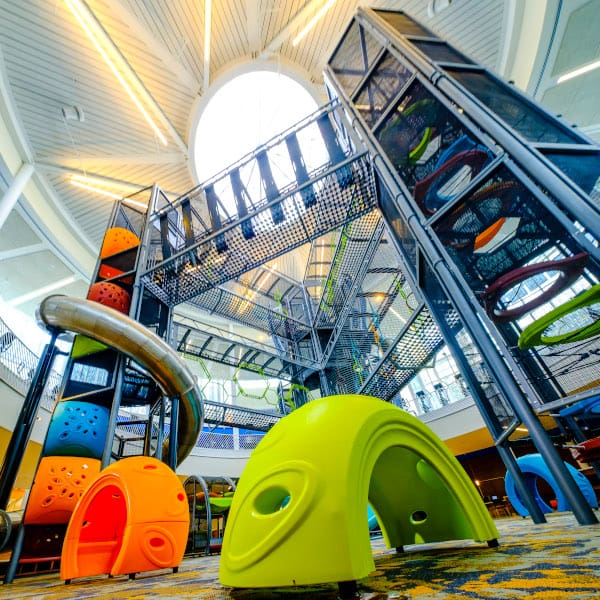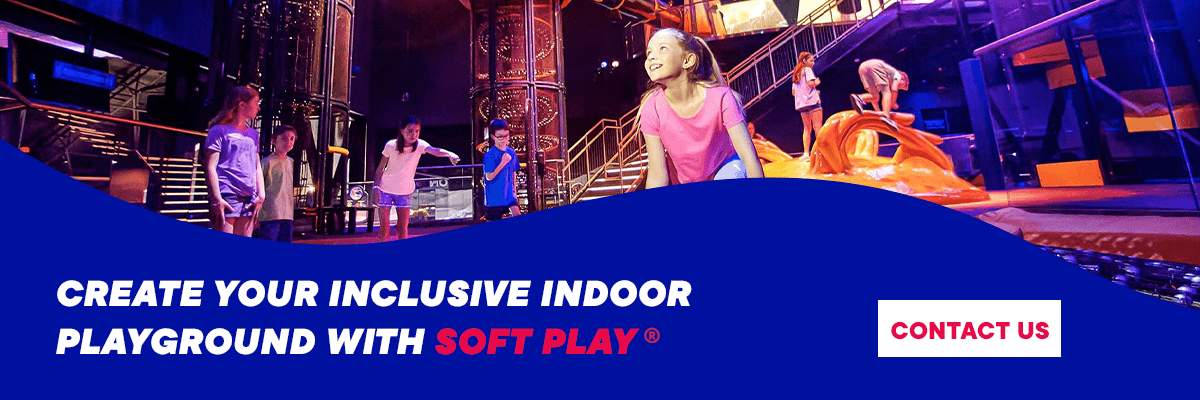Designing an Inclusive Indoor Playground

Designing an Inclusive Indoor Playground
Playgrounds are exciting places that allow kids to let their imaginations run free and experience the fun of unstructured play. The playground also helps kids develop social skills and engage in physical activity, promoting emotional and physical well-being.
Kids have a wide range of physical and cognitive needs, and sometimes regular playgrounds don’t consider those needs. Designing an inclusive play space ensures that kids of all ability levels feel comfortable playing at your indoor playground. This guide will describe inclusive indoor playground design and provide some helpful tips for consideration. Let’s dive in!
Read the full article or skip to a specific section to learn more about inclusive playground ideas:
- How to Design an Inclusive Indoor Playground
- Equipment to Include in Your Inclusive Playground
- How to Assess Your Playground for Inclusivity
- Create Your Inclusive Indoor Playground With Soft Play
How to Design an Inclusive Indoor Playground
What are some fundamental principles for designing an inclusive indoor playground? Below are a few of the top steps for creating an indoor playground that excites every kid who visits your location:
1. Find Ways to Engage Multiple Senses
Multisensory play experiences are an essential element of inclusive indoor playground design. Kids experience the world through their senses, navigating new experiences and orienting their bodies in space. Inclusive playgrounds should include sensory elements that appeal to kids of all ability levels. Enabling kids to build their motor skills and problem-solving abilities as they play in their own way is a great way to encourage learning. Engaging multiple senses with playground equipment involves challenging these senses:
- Tactile: The sense of touch is a powerful tool kids use to engage with the world and maneuver in their surroundings. Tactile elements to include in an inclusive indoor playground include a variety of play panels to challenge kids of all ages and abilities.
- Auditory: The brain recognizes and interprets a range of sounds every day. Kids of all abilities can enjoy musical elements, such as the Tap-A-Tune and Electronic Piano play panels.
- Proprioceptive: The sense of proprioception is one’s awareness of the body’s movements and orientation in space. Kids can enhance this sense by stretching and flexing their muscles with climbing play elements. Examples include soft foam play sculptures and the Spiral Climb, which has upper-level ADA access to include kids of nearly any ability level.
- Visual: Visual stimuli help kids recognize and categorize what they see. Choosing contrasting colors and implementing visually-engaging playground elements like the PXLPLAY™ interactive play panel stimulates kids’ sense of sight.
- Vestibular: The vestibular sense has to do with physical balance. Kids learn how to work with gravity and move their bodies through space by engaging this sense. Interactive play elements like STOMP challenge balance and motor skills.
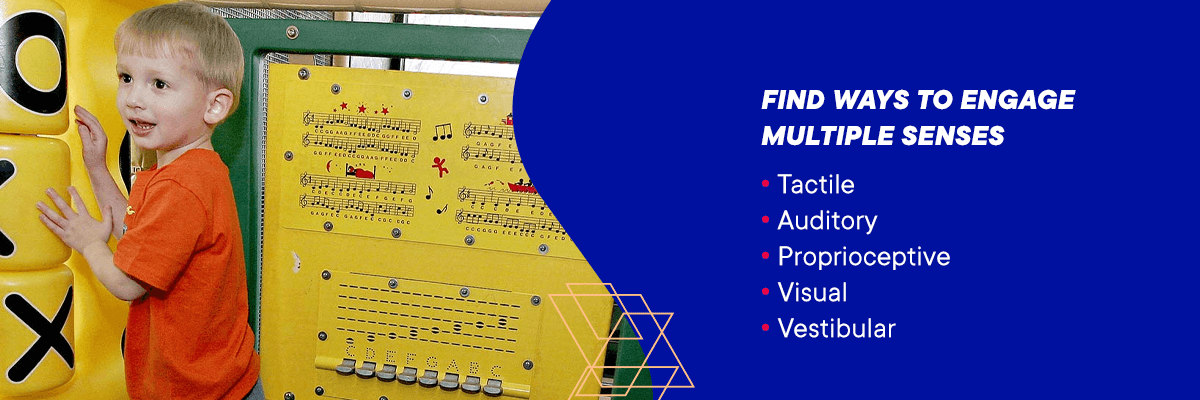
2. Make It An Accessible Playground Design
Although inclusivity is more than accessibility, making an inclusive indoor playground accessible is vital for ensuring that kids of all abilities feel welcome. Choosing the right inclusive indoor playground elements helps all kids enjoy your playground. Accessibility also enables parents and caregivers to watch their little ones in comfort.
Improving playground accessibility involves several considerations, like:
- Entrances and exits: Paths into and out of your indoor playground should be wide enough to easily fit wheelchairs and strollers. Providing wide entrances and exits can also make kids who don’t like to be touched feel more comfortable.
- Maneuvering between play structures: There should be plenty of room for kids with mobility needs to maneuver through the playground. Having wide routes in your playground design can accommodate these differences.
- Playground surfacing: Surfacing is another essential consideration for designing an accessible play area. For kids with mobility issues to feel secure and balanced, playground surfacing should be even and shock-absorbing. Two of the best types of playground surfacing for an ADA-compliant playground are Pour-in-Place rubber and Modular Tiles.
3. Include Different Levels of Challenge
All playgrounds should provide a place where kids of varying ages and abilities can have fun together. Inclusive playgrounds need to cater to a range of physical and cognitive needs. Play should always be engaging and exciting, though kids might have different preferences regarding how much they want to challenge themselves. An inclusive playground makes it easy and fun for kids to play at their own pace.
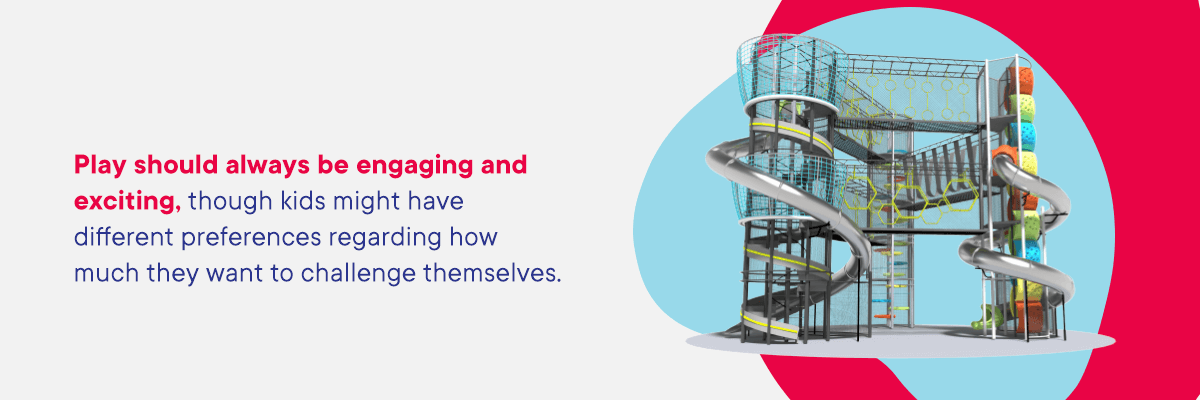
Inclusive playgrounds should feature multiple challenge levels for kids with different abilities and preferences. Every child has their own capabilities and desires about which play equipment they enjoy. Some kids have more physical mobility than others, while others are comfortable with simple play equipment. Adding inclusive indoor playground elements in various difficulties ensures that each visitor to your location gets to play how they want and at the level they enjoy.
When creating an inclusive indoor playground with different levels of challenge, group similar equipment of varying challenge levels together. This will allow kids to choose their method of play based on their ability level and preference while also engaging with others.
4. Set Aside Calm Areas in Your Inclusive Playground Design
A kids’ ability to choose how and where they play is valuable for their learning, growth and self-confidence. Kids need opportunities for play that allow them to make real decisions regarding their likes and dislikes. Choosing how they play is especially important for kids with disabilities or cognitive impairments that might make it challenging to interact with others.
Playgrounds can be bustling and noisy places. Some kids, especially those with ASD, might find crowded, loud play areas overwhelming. Others may not be able to keep up with more active kids and might prefer a slower pace of play. Creating calm, cozy spaces in your inclusive indoor playground is vital for providing these kids with a spot to rest.
If a kid experiences sensory overload, retreating to a tunnel or secluded tube can help them feel safe and comforted. Enclosed spaces like the Bat Box or even underneath play structures with multiple nooks and crannies are also helpful, as long as they are still within sight of parents and caregivers. Provide some quiet spaces where children can retreat to recharge or self-regulate before going back out to play.
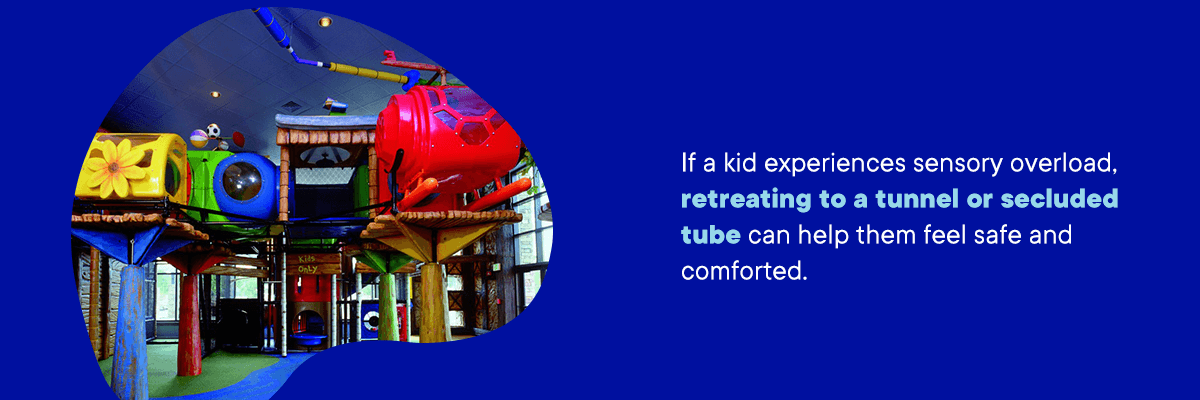
5. Create Spaces for Social Engagement
Playgrounds are environments rich in opportunities for social engagement. Providing space for kids to play and communicate with each other gives them the ability to learn social cues, make friends and handle conflict. Kids in different stages of development might find some social skills difficult, but having the chance to build on those skills in a safe place through play encourages growth.
Inclusive indoor playground design should prioritize social engagement through several different stages of play. Choose indoor playground equipment that supports every stage of play:
- Solitary play: During solitary play, kids explore and imagine on their own. Provide plenty of space for kids to engage themselves without the need for others. Play panels provide an excellent opportunity for solitary play.
- Onlooker play: Kids engage in onlooker play when they watch or talk to others without joining in with the fun. Consider placing some play equipment at a small distance from the main action so kids can observe before deciding whether to join in. An orientation path around the playground also gives kids the opportunity to watch others as they play.
- Parallel play: In parallel play, kids play next to each other without directly engaging in the same activity. Play elements like combo spiral slides allow kids to listen to and watch other kids’ fun as they enjoy sliding themselves.
- Associative play: Associate play is when kids play independently while sometimes interacting with others. This stage of play might find kids mimicking and even conversing with others but still enjoying solitary activities.
- Cooperative play: In cooperative play, kids are fully engaged in the same activities. They might create an imaginary world in which to play, converse together and create rules for the group to follow. Encourage cooperative play with playground elements that require cooperation.
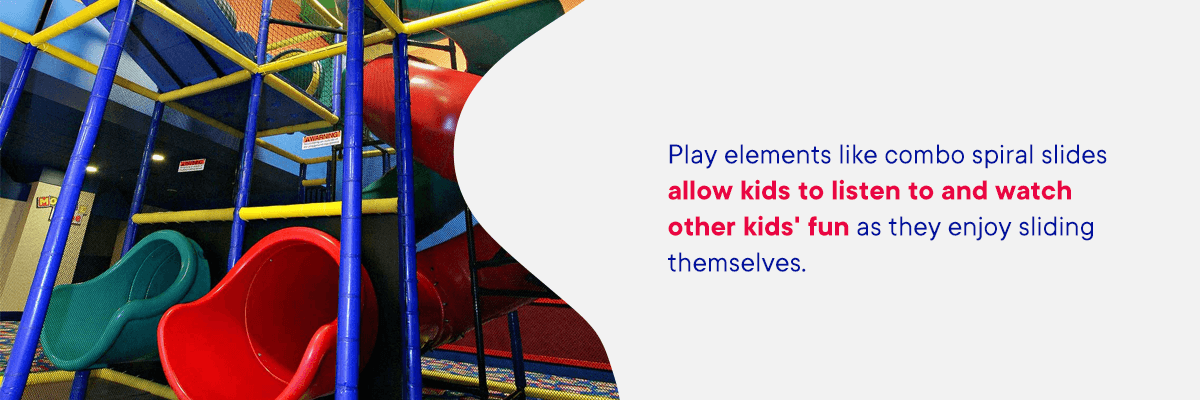
6. Include Many Ground-Level Activities
Providing as many ground-level activities as possible helps kids who use wheelchairs enter and exit play structures easily. All kids feel included when they can access the same activities and play equipment as the others.
Ground-level activities take several forms, and every version allows kids to interact together regardless of ability or developmental differences. For example, play panels are accessible for every kid, whatever their mobility level. Play panels let kids enjoy matching games or interact to make music with others. Soft foam play sculptures are another excellent choice for ground-level activities. Including any free-standing play structure that lets kids stay close to the ground will make your indoor playground more inclusive.
Equipment to Include in Your Inclusive Playground
Inclusive playground elements enable kids of all ability levels to play together. While layout and design are essential, the play equipment you select is vital for creating an inclusive playground. Although kids with specific mobility challenges may not be able to play on every playground element, adding several inclusive play options and features helps them feel included and have fun.
When it’s time to design your playground, consider these inclusive indoor playground elements:
1. Ramps
Ramps are an essential element of any inclusive playground. Ramps allow kids of all ability levels to reach areas up high and enjoy the view from new heights. Ramps enable kids to move freely and provide them with a sense of independence. For kids who are unable or prefer not to use playground transfer systems, a ramp helps them reach elevated play structures.
Including ramps in your inclusive indoor playground design requires some special considerations, including:
- Space requirements: Ramps take up more space than stairs. Ensure your location has plenty of room for ramps at the necessary entry and exit points to avoid overcrowding your playground. Be mindful that kids using wheelchairs also need space to turn around at the top of the ramp before coming back down.
- Handrails: Accessible handrails give kids a sense of security and help kids using wheelchairs pull themselves up the ramp. Choose ramps with double rails so kids can use the handrails at different heights.
- Surfacing: Including ramps in your playground design is only beneficial if kids using wheelchairs can easily navigate throughout the playground. Look for level, even surfacing to ensure that kids and caregivers can control their wheelchair’s movement.
2. Inclusive Slides
Slides are one of the most popular playground elements available. Kids love the thrill of zooming down slides and feeling the wind in their faces. Slides are also beneficial for kids’ sensory development. Slides help kids strengthen their vestibular and proprioceptive senses, helping them learn to control their bodies as they move.
Fortunately, improvements in inclusive playground design have also made it possible for kids with mobility challenges to enjoy the freedom of a slide. For example, some slides have a lower point of transfer on the ground where kids using wheelchairs can access the slide from ground level. Kids can then use a side rail to pull themselves up the slide as they feel comfortable. Then they can glide back down.
If you need accessible slides to fit a room of specific dimensions, you can also look into custom slides. You can create an inclusive slide to the exact height specifications you want, so kids of all abilities can enjoy sliding at your inclusive playground.
3. Wheelchair-Accessible Equipment
Providing kids who use wheelchairs with the opportunity for movement and play is also beneficial for their wellness. Since these kids spend most of their time in a wheelchair, moving with the help of accessible play equipment can help them improve their balance and coordination.
However, these kids with unique needs require special equipment that can accommodate their mobility level. As you consider what equipment to order for your indoor playground, look for elements that enable kids to use their wheelchairs as they play alongside friends. Creating a wheelchair-accessible playground might include installing play panels that kids in wheelchairs can easily reach or incorporating other ground-level elements.
You might have special design or space considerations to incorporate into your wheelchair-accessible equipment. If this is the case, custom playground elements are an excellent option. You can work with a playground equipment design team to create a unique playground with wheelchair-accessible elements. Your imagination is the limit when designing custom indoor playground equipment.
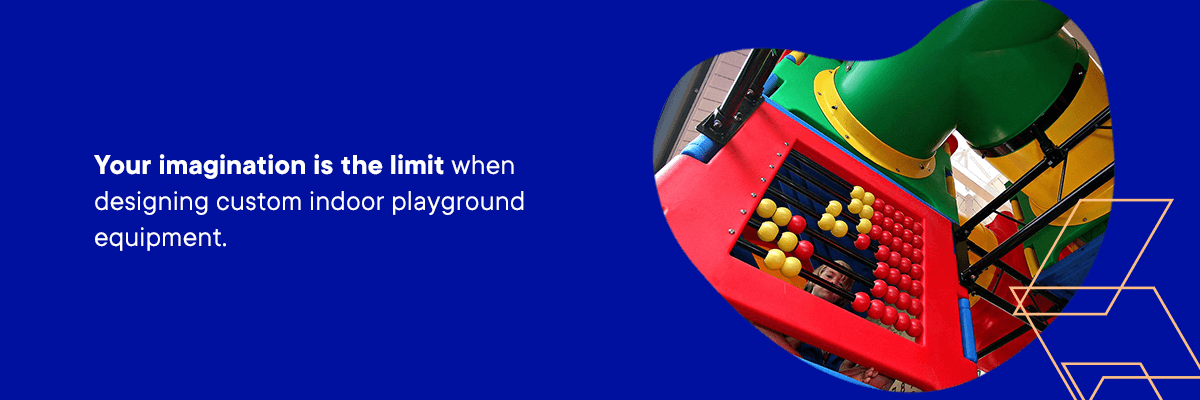
4. Our Products
For over 30 years, Soft Play® has provided businesses with high-quality and thrilling play equipment. Providing kids with opportunities for active play is our passion, and we’re a leader in finding new ways to do it. Many of our play elements and structures are upper-level ADA-accessible, like the Spiral Tree Climb. We also offer a broad range of accessible play elements, including:
- Sculpted foam play elements: When creating an inclusive indoor playground that appeals to kids of all ability levels, sculpted foam play elements are a great option. Soft foam sculptures are durable and versatile, giving kids several options for incorporating them into their play. At Soft Play, we can completely customize our handcrafted soft foam play elements so they fit your space and overall vision.
- Tunnels: Tubes and tunnels are an excellent choice for an inclusive indoor playground. Tunnels usually connect different play structures, but they are also fun on their own. These cozy spaces appeal to kids of all abilities and provide a restful refuge.
- Play panels: One of the best types of inclusive playground equipment is a play panel. These elements are ADA-accessible, appealing to kids of all ages and abilities and providing sensory stimulation and learning opportunities. Our play panels range in difficulty level, so you can choose the equipment that best suits your visitors.
- Musical play equipment: Musical play equipment provides several benefits to all kids, including opportunities for social engagement, sensory play, solitary play and strengthening motor skills. We offer a range of musical play equipment, including our Concerto series that is ADA-accessible.
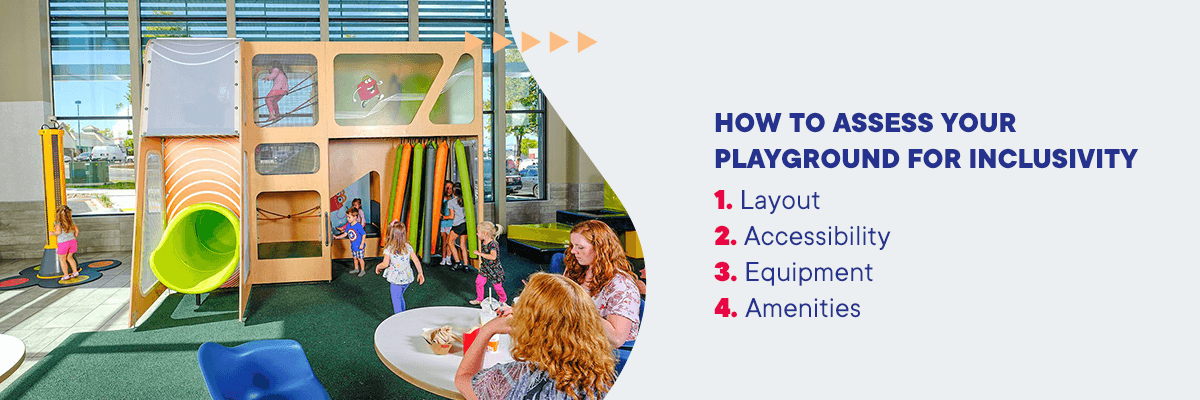
How to Assess Your Playground for Inclusivity
Designing an inclusive indoor playground takes careful consideration of your playground’s design, layout and elements. Inclusive playgrounds often need creative solutions for bringing kids together and meeting their needs for play. Evaluate your playground for inclusivity by considering the following areas:
1. Layout
Improving your playground layout can boost inclusion and create a more usable play area. Ask yourself these questions about your playground’s layout:
- Do your playground’s perimeters serve kids who may want to watch from the outskirts?
- Are kids with mobility needs able to easily navigate to the play structures designed for their needs?
- Does your playground provide spaces where kids can retreat from the activity?
2. Accessibility
Provide a playground where kids of all abilities can comfortably navigate throughout the space. Ask questions like these to determine accessibility:
- Do the playground entrances accommodate kids of all mobility levels?
- Can kids and adults using wheelchairs navigate the playground and access different play structures?
- Is there sufficient spacing for kids who use wheelchairs to maneuver between elements?
- Are there slopes or surfacing that make wheelchair navigation difficult?
3. Equipment
The design and location of your play equipment affect your playground’s inclusivity. When evaluating your playground’s equipment for inclusivity, you may ask:
- Does your playground include several inclusive play activities?
- Do playground activities engage multiple senses to provide rich sensory experiences?
- Can kids of all ability levels play together?
- Are there spaces or activities for quiet play?
4. Amenities
Supporting playground amenities can help your inclusive indoor playground stand out and better serve your patrons. These questions can help you determine whether your amenities are inclusive for all visitors:
- Are rest areas easily accessible to parents and caregivers?
- Is there plenty of seating for caregivers?
- Can kids who use wheelchairs easily navigate to the rest areas?
Create Your Inclusive Indoor Playground With Soft Play
At Soft Play, our commitment to excellence allows you to provide unforgettable play experiences to your location’s visitors. We understand that inclusivity and accessibility matter for giving kids of all abilities the chance to play freely. We manufacture high-quality ADA-compliant play equipment tailored for unique needs. Our designs are also customizable for all budgets and spaces, so you can create the playground that best serves your visitors.
Start your inclusive indoor playground today with a free design consultation. Contact us to request a quote on our playground equipment or get more information.
